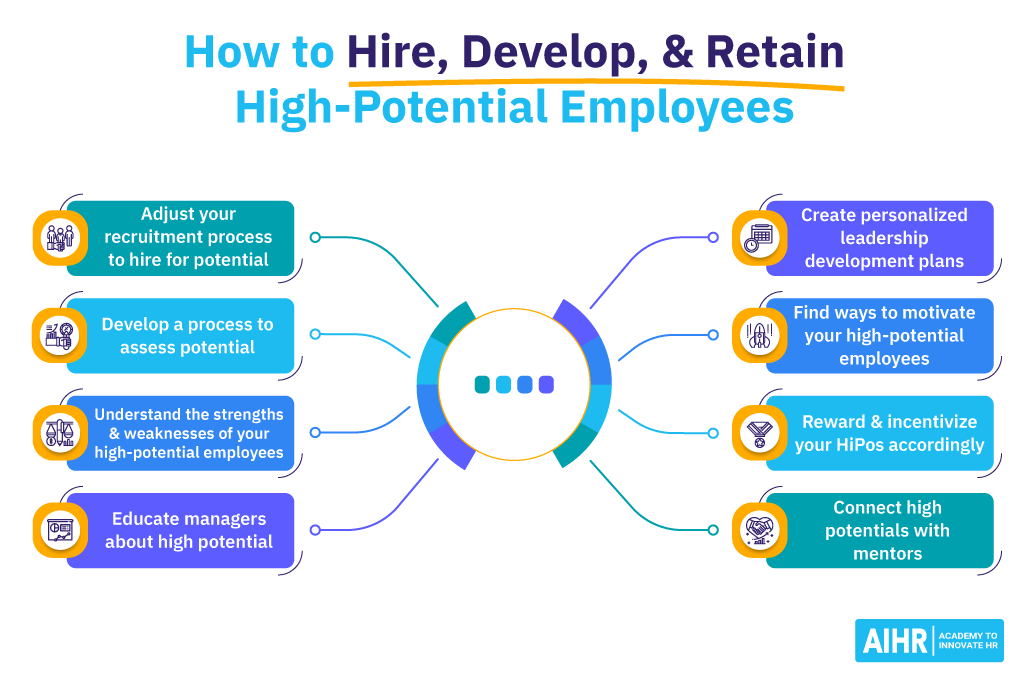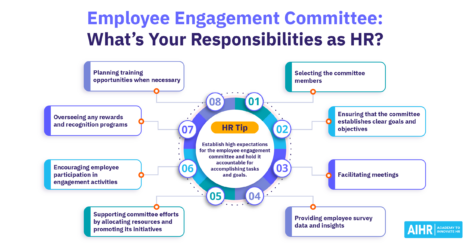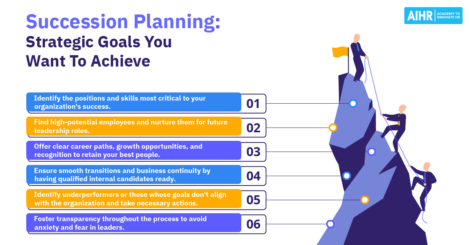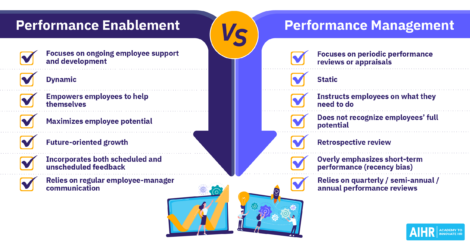8 Tips to Hire, Develop, and Retain High-Potential Employees

High-potential employees have the aptitude to become the future leaders of your organization. However, many businesses struggle to identify, develop, and retain such employees. Here’s all you need to know about high-potential employees.
Contents
What are high-potential employees?
Characteristics of high-potential employees
High potentials vs. high performers
Why should you identify your high-potential employees?
How to hire, identify, develop, and retain high-potential employees
What are high-potential employees?
A high-potential employee (HiPo) is a person whose current abilities reflect a strong probability that they can develop into a successful leader.
Although high-potential employees may become your future executives, their leadership skills contribute strongly at every level of the organization. When you place the kind of employees who make sound decisions in the right roles, you can better reinforce organizational goals.
HR professionals have the expertise to recognize the characteristics of high-potential employees and can help design effective leadership development programs to support HiPos’ growth. The more potential someone has, the more straightforward and efficient it is to nurture their skills, competencies, and capabilities.

Characteristics of high-potential employees
There are various personality traits and behaviors that make high-potential employees stand out. Here are some of the characteristics to be looking for:
- Emerging leadership competencies – Exemplifies key areas that demonstrate the ability to lead oneself, others, and the organization. Exhibits leadership potential.
- Autonomy – Gets the job done on time without reminders or close supervision.
- Initiative – Eager to take on more work or new projects and influence decisions by brainstorming ideas and solutions.
- Curiosity – Enthusiastic to learn about the business. Asks questions about why decisions are made to better understand the strategy and propose other approaches.
- Growth mindset – Pursues ways to gain new skills and take on responsibilities beyond their job description. Steps in to help solve problems.
- Collaboration – Establishes trust and strong relationships by valuing other coworkers and departments and helps out when others are overwhelmed. Works successfully on group projects.
- Receptive to feedback – Accepts all feedback with an open mind for learning and improvement.
- Flexibility – Adapts to rapid change and new ideas with an ability to abandon or negotiate current perceptions or ways of working.
- Conscientiousness – Pays attention to details and does work thoroughly. Able to empathize with team members and customers.
- Investment in company success – Contributes to a positive work environment and shows interest and commitment to the organization’s mission and goals.
- Copes with pressure – Maintains composure in heated situations and while taking risks. Sets an example of steady guidance during challenges. May even thrive while working under pressure and in stressful situations.
High potentials vs. high performers
Performance is often confused with potential. Not every high potential is a high performer and vice versa. Just because someone consistently achieves results doesn’t mean they are cut out for leading others. If performance becomes the most important factor, the more subtle attributes needed for long-term success are passed over. Then you risk losing high-potential employees who have been overlooked.
Let’s look at the example of a sales department. Sales managers are often promoted into their positions because they are the top sellers. However, not all of them will have the right skill set or strong desire to successfully guide and motivate staff. They can end up being less valuable to the business as a manager than they were as a salesperson.
On the other hand, a salesperson who isn’t a top performer may have many high potential qualities that equip them to handle the pressure of leading and inspiring others. They could emerge as an excellent manager who drives better sales numbers.
Why should you identify your high-potential employees?
Organizations that adopt a high potential talent mindset will reap many benefits. Here are a few reasons why you should take advantage of what high-potential employees have to offer:
They bring value to the team and the organization
HiPos are productive, reliable workers that encourage and motivate other team members, contributing to a positive work environment. Their eagerness to learn and desire for a challenge prompts them to take on projects or additional responsibilities when others won’t. When challenges arise, HiPos use critical thinking and innovation to overcome them.
They’re great candidates for becoming leaders
Succession planning is easier when you have a steady source of future leaders. You can develop HiPos faster thanks to their willingness to learn and grow. It also costs you less money than nurturing someone who requires more training or hiring from outside for the leadership roles.
When you invest in HiPos, they feel valued and more connected to the organization. As leaders, they will have loyalty to the company and act as trusted brand advocates.
You can create purposeful strategies to retain them
You want to keep your top talent for a long time. When you focus on the concept of high potential and identify who your HiPos are, you can create targeted strategies for developing and retaining them.
According to a survey done by the Center for Creative Leadership, it was very important to 77% of the respondents to be formally named a high potential. Furthermore, doing so made them less likely to seek other employment.
When employees are identified as HiPos, they believe you’ve recognized their hard work. They have a vision of where the company is taking them and feel more purposeful and engaged in their jobs. As they take each development step, their level of commitment to the organization is likely to increase.
How to hire, identify, develop, and retain high-potential employees
Once you decide to explore high potential within your workforce, you’ll need to introduce and maximize your HiPo process. Here are eight steps you can take:
1. Adjust your recruitment process to hire for potential
One of your crucial recruiting goals should be to attract and recruit high potentials. This is especially true when you’re hiring for more junior roles. You can focus less on applicants’ education and experience and more on their personality traits and behavior.
Here are a few ideas for drawing in HiPos:
- Rewrite your job postings and update your careers page to include growth possibilities – Be clear that there are plenty of development opportunities to grow within the organization. Explain that talented employees will thrive in your work environment and are crucial to the company’s success.
- Look for initial signs of potential in candidates – Dig deeper into resumes beyond just the facts about their experience and accomplishments to see how they describe what they’ve done. Do they use words and phrases that convey initiative and leadership?
- Seek potential in your hiring process – Adjust your mindset to focus on what’s behind the words on a candidate’s resume. Ask interview questions that fill in the gaps and uncover high potential qualities. Here are a few sample questions:
- “What are the skills or strengths you would like to further develop in the next few years?” (You’ll be able to see how self-aware they are and which skills are their priority.)
- “In what types of situations do you depend on colleagues to ensure a better outcome”? (Their answer will reveal how they approach collaboration and teamwork.)
- “Tell me about an accomplishment in a previous role that you are most proud of.” (The way they tell the story behind the accomplishment will show how they used their skills and whether they take all the glory or give credit to others.)
You should also consider the candidate’s interview prep. Are they equipped to make insightful, nuanced responses? Are they comfortable talking about their previous roles or complex work situations? Do they ask perceptive questions about the company?
2. Develop a process to assess potential
Instead of relying solely on subjective criteria for assessing potential, you should use an analytical method. There are various tools you can draw on to help predict who could be a high potential employee by weighing their capacity for leadership, critical thinking, and communication.
One popular tool is a 9-box grid that groups workers according to their potential and performance, but it’s often considered outdated. Another technique is 360-degree feedback which is a reliable method to assess potential by gathering performance ratings and input from multiple sources.
You can also conduct:
- Psychometric assessments that measure a person’s personality, cognitive ability, or work behavior.
- Aptitude tests for gauging professional competency and skills.
- A High Potential Trait Indicator (HPTI) for exploring personality traits to evaluate suitability for a particular role.
It’s essential to be consistent in how you assess potential to uphold fair and inclusive HR practices.
3. Understand the strengths and weaknesses of your high-potential employees
No matter how much potential someone has, they are bound to have some weaknesses. Each person has a unique set of positives and negatives. This means there will be no one-size-fits-all approach to developing your HiPos.
There should be methods for encouraging valuable traits and coaching for the shortcomings. By understanding and helping HiPos recognize and work with their strengths and weaknesses, you can determine what their career path within your organization could look like and what to focus on developing.
4. Educate managers about high potential
HR should ensure training and support are available for management to grasp your high potential program and help move it along.
Frontline managers see their people in action and are central in ascertaining which ones are leadership material. Although they may have excellent instincts about who the standout employees are, team leaders need more context for recognizing high potentials. They should be able to distinguish between high performance and high potential and know how to avoid bias in their observations.
Managers should also be a driving force in their HiPos’ development, so they need to understand the organization’s plan and their role in it.
5. Create personalized leadership development plans
Making a commitment to developing high-potential employees will get them where you need them to be. Especially when working on your succession planning, which some of your high potential employees will be part of, you should create leadership development plans. This way, you can prepare individuals for leadership positions that align with your business strategy.
You could have general plans for the different management levels (emerging, mid-level, executive) that include a variety of competencies. Since every person will have unique development objectives and learning preferences, the ideal plan would consist of multiple tools and resources that you can customize to each person’s needs.
One large-scale example of a leadership development plan is that of digital marketing company PMG. It targets high-potential college graduates with a Graduate Leadership Program. Participants get to launch their careers with full-time jobs that provide training, support, and hands-on experience. This also comes with the chance to become the future leaders in every area within PMG’s business.
6. Find ways to motivate your high-potential employees
When high potential employees feel engaged and inspired by their work, they will be motivated to put their best foot forward. Investing in your HiPos will help them see a clear path forward and want to stay with the organization. As we mentioned before, this is why managers need to be in the loop on how to support high potentials.
Some ways managers and leaders can motivate and nurture HiPo employees include:
- Supplying constructive feedback on their performance to help them perform better and achieve the superior results and recognition they desire.
- Providing prospects with ideas for their future with the organization by creating career paths for them to learn and progress.
- Giving them challenges, special projects, and stretch assignments. Taking risks will build their confidence from having to move beyond their comfort zone and overcome setbacks.
- By offering plenty of experiential learning and leadership opportunities, you’re equipping them to take on advanced roles.
7. Reward and incentivize your HiPos accordingly
High potentials need goals and rewards to work toward. There must be clear, achievable criteria for how they can earn a bonus or a raise. Managers should work with their HiPos to set specific milestones that will be rewarded when the employees reach them.
Organic recognition is also meaningful. Verbal praise for behind-the-scenes accomplishments, such as dedication and enthusiasm for a project, makes HiPos feel important to the organization and appreciated for the extra effort they are putting in.
9. Connect high potentials with mentors
A mentoring relationship gives HiPos more exposure to leadership and allows them to learn directly from leaders’ expertise. They will gain valuable insight and also build their professional network.
Mentors can share wisdom from both their triumphs and mistakes, as well as coach HiPos through their growing pains. You can implement a long-term mentorship program or micro-mentoring opportunities to do this.
In a nutshell
HiPos are highly valuable assets that can be a real competitive advantage for your organization. If you want to successfully identify, engage, and retain high-potential employees, you need to lay a foundation with the right strategy. You need to know how to assess potential, how to motivate and reward them, and most importantly, how to help them reach their full potential.
Weekly update
Stay up-to-date with the latest news, trends, and resources in HR
Learn more
Related articles
Are you ready for the future of HR?
Learn modern and relevant HR skills, online











